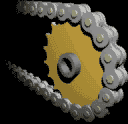
Problem D: Tour de France
A racing bicycle is driven by a chain connecting two sprockets.
Sprockets are grouped into two clusters: the front cluster
(typically consisting of 2 or 3 sprockets) and the rear cluster
(typically consisting of between 5 and 10 sprockets). At any
time the chain connects one of the front sprockets to one
of the rear sprockets. The drive ratio -- the ratio of the
angular velocity of the pedals to that of the wheels -- is
n:m where n is the number of teeth on the rear sprocket and
m is the number of teeth on the front sprocket.
Two drive ratios d1<d2 are adjacent
if there is no other drive ratio d1<d3<d2.
The spread between a pair of drive ratios d1<d2 is
their quotient: d2/d1.
You are to compute the maximum spread between two adjacent
drive ratios achieved by a particular pair of front and
rear clusters.
Input consists of several test cases, followed by a line containing 0.
Each test case is specified by the following input:
- f: the number of sprockets in the front cluster;
- r: the number of sprockets in the rear cluster;
- f integers, each giving the number of teeth on one of the gears in the front cluster;
- r integers, each giving the number of teeth on one of the gears in the rear cluster.
You may assume that no cluster has more than 10 sprockets and
that no gear has fewer than 10 or more than 100 teeth.
For each test case, output the maximum spread rounded
to two decimal places.
Sample Input
2 4
40 50
12 14 16 19
0
Output for Sample Input
1.19
Ondrej Lhotak and Gordon V. Cormack

This work is licensed under a Creative Commons Attribution-ShareAlike 3.0 Unported License.

